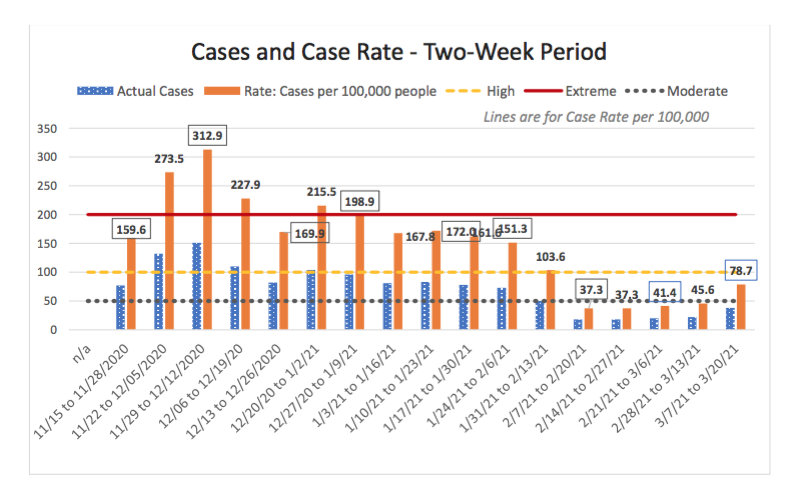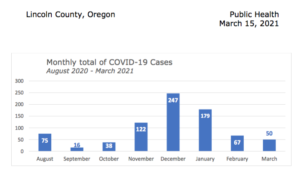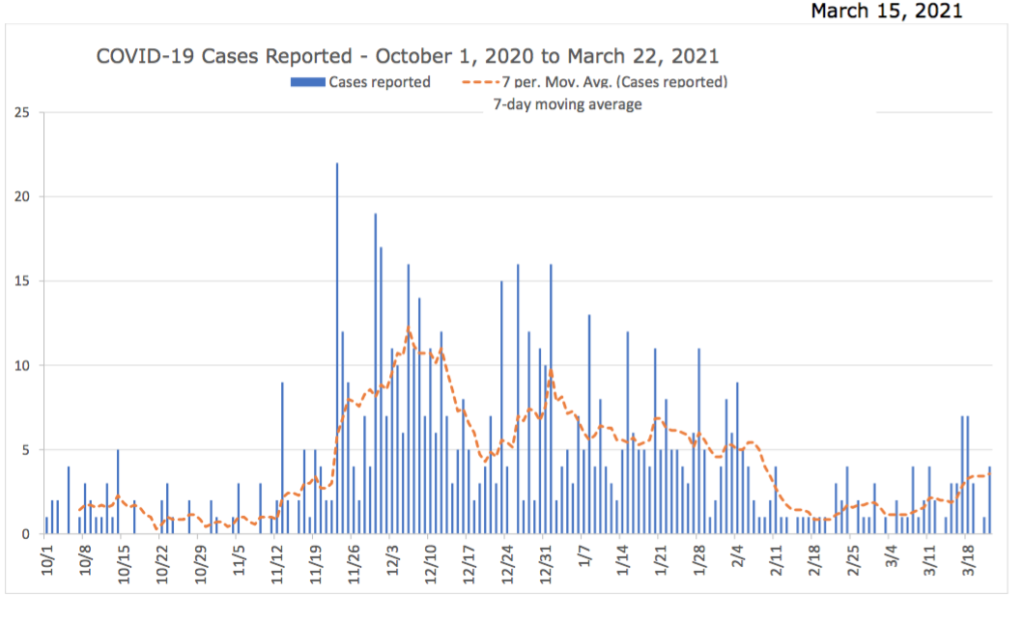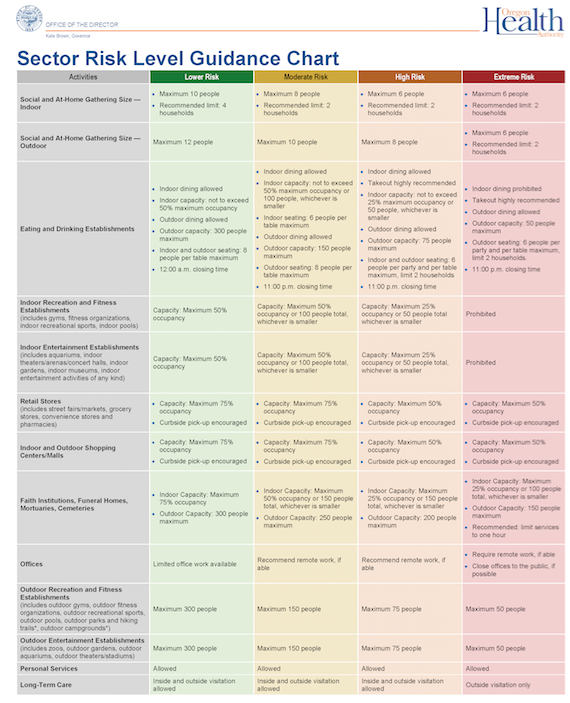
By QUINTON SMITH/YachatsNews.com
and GARY WARNER/Oregon Capital Bureau
A small increase in the number of COVID-19 cases in Lincoln County will mean slightly tighter restrictions on some businesses and social gatherings starting Friday.
Because of the increase, the Oregon Health Authority is moving the county from the “low risk” category – where it has been for a month – to the “moderate risk” category.
Counties are assigned one of four risk levels based on the spread of COVID-19 infections: extreme, high, moderate and lower. The higher the level, the more restrictions on activities, businesses and gatherings.
In Lincoln County, the effect will be slightly lower numbers for at-home and social gatherings, shortening restaurant and bar closings by an hour, and cutting capacity at aquariums, theaters and churches. It should not affect attendance at Lincoln County School District sporting events because the district is still not allowing spectators, despite being given permission to do so by the state.
Lincoln County has been below the state’s COVID-19 threshold since late February, allowing it to be one of 13 Oregon counties with the “low risk” designation. It is now one of three moving out of that category Friday.

Since February, the county has had 37 to 45 COVID-19 cases per 100,000 population every two weeks – or half of that, based on its actual population of 48,000. As of Saturday, the county’s rate was 78 cases per 100,000 from March 7-20, or 39 cases during that period. The cutoff between the low and moderate categories is 50 cases per 100,000 population, or 24 cases every two weeks for Lincoln County.
Lincoln County deputy health director Florence Pourtal told county commissioners Monday that there was no single reason for the increasing number of cases. She said there were outbreaks of 3-6 cases stemming from a birthday party, a restaurant, and a high school sports team. The Oregon School Activities Association said the school outbreak occurred among members of the Taft High School football team.
“We were doing really good in February … but we are seeing an increase the past few weeks,” she said.
Commissioner Claire Hall pushed back on social media comments that the increased cases were due to visitors.
“These are local people, local activities,” she said.
Commissioner Doug Hunt said just because thousands of county residents are getting COVID-19 vaccinations each week “doesn’t mean we change our precautions” of wearing masks and social distancing.
A new state rule grants a two-week grace period to counties that reduced their risk level in the prior period but rebounded with higher numbers in the next period.
Instead of immediately returning to the more restrictive rules, the counties get a two-week “caution” period to try to get their numbers down again. If they are unsuccessful, then OHA will move the county up at the next risk level adjustment.
This week, the caution period was granted to two counties — Josephine and Klamath.
Lincoln County health officials unsuccessfully appealed to the OHA to be included in the two-week caution.

Overall, state is heading in right direction
But overall, Oregon’s new COVID-19 risk levels show improving conditions around the state as officials expect to pass the one million shot mark on vaccinations.
“We are seeing the light at the end of the tunnel get a little brighter,” Gov. Kate Brown said Tuesday in a statement.
Overall, the news was good as none of the state’s 10 most populous counties is in the extreme risk category and just three are high. The rest are moderate or lower risk.
In January, 27 out of the state’s 36 counties were rated as extreme risk, including most of the population centers in Oregon. All three Portland-area counties remained in the moderate risk category.
Statewide, 14 counties are in the lower risk level. Fourteen counties were at moderate risk level and six counties are at high risk.
Two counties are at extreme risk. Coos County’s rising numbers moved it up from high to extreme, where it joined neighboring Curry County.
In the northwest coast, four counties were all in the moderate risk level, but got there in different ways. In Clatsop and Lincoln counties, rising indicators moved them up from lower, while Columbia County’s improvement dropped it from high. Tillamook County remained the same.
The three-county Central Oregon area saw Deschutes County’s numbers of cases and infection rates continue to drop, just not enough to move it into the lower risk category. Jefferson County, which up to a month ago had some of the worst infection numbers in the state, improved enough to drop two levels, from high to lower. Crook County saw a slight uptick in numbers, but not enough to move it out of its lower risk rating.
The Oregon Health Authority sees COVID-19 rates in southwestern Oregon as troublesome. No county that is west of the Cascades and south of the Willamette Valley is at better than high risk and many are in or just exited extreme risk.

During testimony last week before the House Subcommittee on COVID-19, OHA Director Pat Allen said the issue wasn’t just vaccine hesitancy, but “vaccine obstinacy.” Allen said six months of data from vaccination efforts show demand “varies wildly” around the state.
While vaccination appointments are booked weeks in advance in most areas, southwest Oregon hasn’t matched its demand with its supply. Allen said a recent mass vaccination event in Douglas County did not come close to filling its eligible slots for shots.
“It’s an indication they are running out of people who are interested in being vaccinated,” Allen said.
The next revision of risk levels will be announced April 6 and will go into effect April 9.
Largest counties and risk status
Seven of the 10 largest counties in Oregon are now at moderate or lower risk level; none are in the extreme risk category.
- Multnomah (pop. 829,560) moderate
- Washington (pop. 620,080) moderate
- Clackamas (pop. 426,515) moderate
- Lane (pop. 381,365) lower
- Marion (pop. 349,120) high
- Jackson (pop. 223,240) high
- Deschutes (pop. 197,015) moderate
- Linn (pop. 127,320) moderate
- Douglas (pop. 112,530) high
- Yamhill (pop. 108,605) lower
County risk levels
Effective March 26 to April 8:
Lower risk (14)
Baker (moved from moderate), Crook, Gilliam, Harney, Hood River, Jefferson (moved from high), Lake, Lane (moved from moderate), Morrow, Sherman, Wallowa, Wasco, Wheeler,
and Yamhill (moved from moderate).
Moderate risk (14)
Clackamas, Clatsop (moved from lower), Columbia (moved from high), Deschutes, Grant (moved from lower), Klamath, Lincoln (moved from lower), Linn, Malheur, Multnomah, Polk (moved from high), Tillamook, Union, and Washington.
High risk (6)
Benton, Douglas (moved from extreme), Jackson, Josephine, Marion, and Umatilla.
Extreme risk (2)
Coos and Curry (moved from high).




